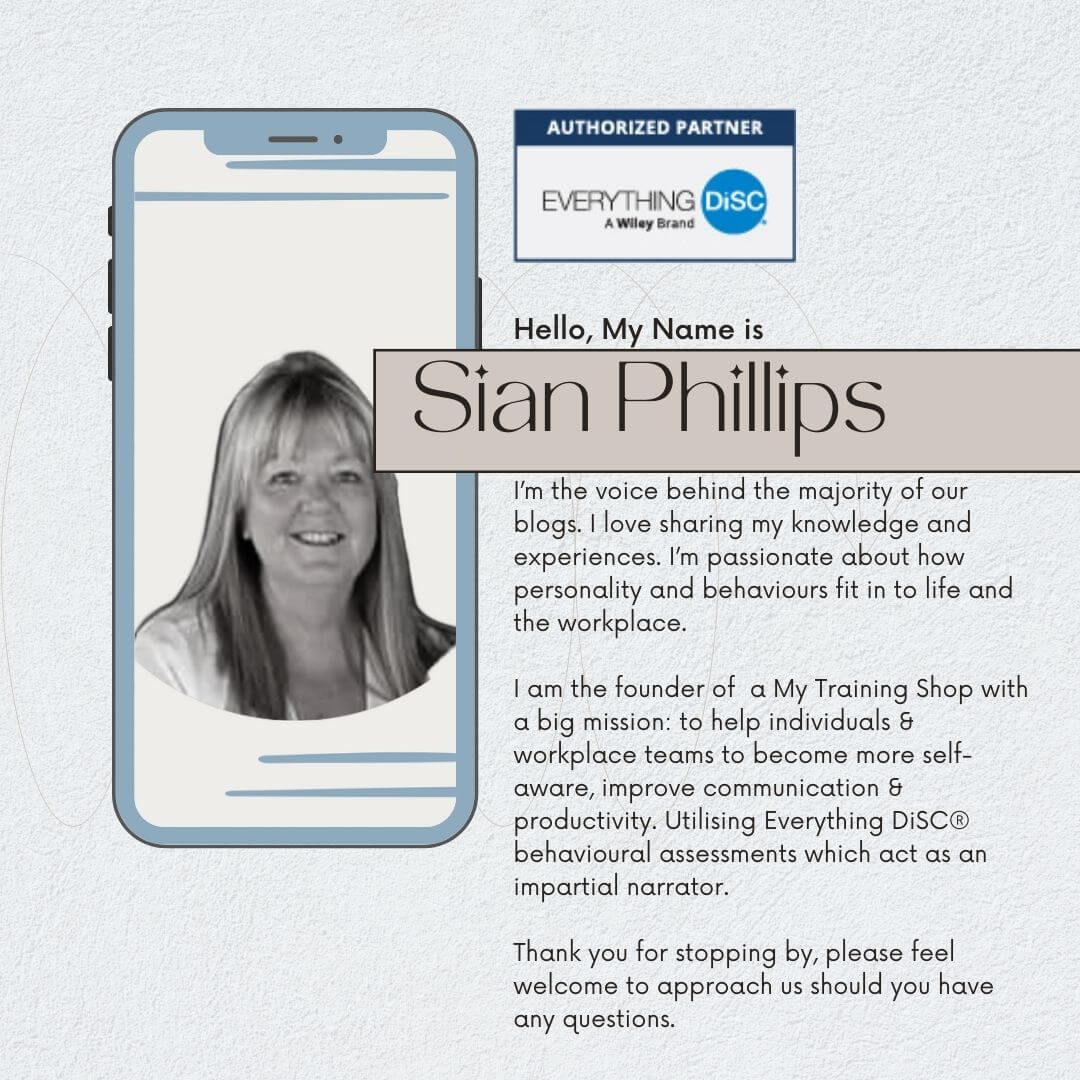The Role of EDI and DiSC in Creating a Resilient Workforce
During my twenty years of working with organisations across the UK, I've observed something remarkable: when businesses understand both their team's diverse backgrounds and their behavioural preferences, they build something truly powerful - resilience.

As someone who's led plenty of Everything DiSC® behaviour assessment workshops, supported trainers to do the same and been involved with countless EDI initiatives, I've seen first-hand how these two areas create a powerful synergy when thoughtfully integrated.
In a recent CIPD survey of 1,178 employers conducted in April, around two-fifths of employers believed that their prior investment in diversity and inclusion would help them respond effectively to employee needs (43%) and customer needs (41%) during a crisis.
Yet many organisations still treat EDI and behavioural understanding as separate initiatives. Here at My Training Shop, Today, I want to share what I've learned about bringing these crucial areas together to create truly resilient workforces.
Key Takeaways
-
-
Organisations integrating EDI with behavioural understanding report better adaptability to change
Wiley's Everything DiSC® behaviour assessments provides a neutral framework for appreciating differences
UK businesses implementing combined approaches see higher employee engagement
Teams with diverse behavioural styles show better problem-solving capabilities
-
The Foundation: Understanding EDI and DiSC

Today's approach to Equality, Diversity and Inclusion goes far beyond compliance. Leading UK organisations recognise that EDI directly impacts business performance, innovation, and resilience.
The McGregor-Smith Review highlighted that full representation of ethnic minorities in the UK workforce would contribute £24 billion annually to the economy. Similarly, government research shows that gender-diverse companies are 15% more likely to outperform their competitors.
DiSC behaviour assessment provides a complementary dimension to this understanding. While EDI focuses on demographic and cultural diversity, DiSC illuminates the diversity of thought and behavioural preferences that exist in any group. This behavioural understanding creates a powerful foundation for appreciating differences.

Last year, I worked with an NHS trust in Manchester where combining these approaches transformed their team dynamics. By understanding both cultural backgrounds and behavioural preferences, they developed communication protocols that addressed both aspects of diversity. The result was improved incident reporting, as staff felt more comfortable raising concerns across both cultural and behavioural differences.
Behavioural Diversity as Competitive Advantage
Functionally diverse teams are more likely to solve complex problems requiring creativity and innovation compared to homogeneous groups. This aligns perfectly with what I've observed across various sectors - teams with a balance of DiSC styles consistently outperform those dominated by a single behavioural approach.

Consider a professional services firm in Leeds I supported last year. Their leadership team was heavily weighted toward D (Dominance) styles - driving fast decisions but missing important details. By intentionally incorporating team members with S (Steadiness) and C (Conscientiousness) profiles and creating processes that valued these different approaches, they reduced client complaints while actually increasing decision speed.
The CIPD's recent report on workplace resilience confirms this pattern, noting that "organisations with diverse behavioural profiles demonstrate greater adaptability during periods of disruption." This makes intuitive sense - different behavioural styles bring different strengths to crisis management.
Cultural Integration Through Behavioural Understanding
One of the most powerful applications I've seen is using DiSC behaviour assessment as a neutral framework for discussing differences. Unlike some aspects of diversity, behavioural styles are non-hierarchical - no style is inherently "better" than others. This creates a safe space for exploring differences.

One of the trainers we supply was working with a manufacturing company in Birmingham that struggled with tensions between different ethnic groups in their workforce. Traditional EDI training had a limited impact. When the trainer introduced DiSC as a complementary approach, team members began to recognise that some perceived cultural differences were actually behavioural preferences. This shift in perspective reduced complaints and improved cross-team collaboration significantly.
The Institute of Leadership & Management's research supports this approach, finding that "frameworks that depersonalise differences create psychological safety for exploring diversity." DiSC provides exactly this kind of framework, offering language for discussing differences without judgment.
Building Resilience Through Integrated Approaches

When organisations understand both the cultural and behavioural dimensions of their teams, they build remarkable resilience. The Financial Conduct Authority (FCA) and Prudential Regulation Authority (PRA) consider that greater levels of diversity and inclusion can improve outcomes for markets and consumers by helping reduce groupthink, supporting healthy work cultures, improving understanding of diverse consumer needs, and unlocking diverse talent.
I witnessed this with a retail chain in Scotland during the pandemic. Their stores with leaders trained in both EDI principles and DiSC behavioural understanding adapted to rapid changes more effectively. These leaders could tap into the strengths of different team members:
Using D styles to drive quick decisions - i styles to maintain team morale.
S styles to provide stability - C styles to ensure compliance with rapidly changing regulations.

The results were compelling: these stores reopened 37% faster and reported 45% better staff retention during the crisis. This pattern repeats across sectors - organisations that combine these approaches build teams that bend rather than break under pressure.
Implementation Strategies
Based on my experience, along with trainers, we supply DiSC reports to UK organisations, effective implementation follows a predictable pattern:
Start with an assessment. Before making changes, understand your current position on both EDI metrics and behavioural distribution. This provides a crucial baseline. Many organisations we work with are surprised to discover behavioural homogeneity in teams they thought were diverse.
Develop integrated training. Rather than treating these as separate initiatives, create learning experiences that connect EDI principles with behavioural understanding. For example, when exploring unconscious bias, examine how behavioural preferences might influence perceptions of different groups.

Review systems and processes. Ensure your organisational processes value both cultural and behavioural diversity. A financial services firm in London discovered their performance review system unintentionally favoured D and i behavioural styles, disadvantaging team members from cultures that emphasise modesty about achievements.
Measure what matters. Track both traditional EDI metrics and behavioural diversity indicators. A technology company in Cambridge found that teams with greater behavioural diversity delivered projects 32% faster than homogeneous teams, providing a compelling business case for their integrated approach.
Future Directions
The future of EDI and behavioural understanding is increasingly integrated. Research from UK universities indicates that organisations treating these as connected aspects of diversity will significantly outperform those maintaining siloed approaches.

Emerging technologies are enabling a more sophisticated understanding of these connections. Advanced analytics can now identify patterns in how different behavioural styles interact across cultural boundaries, enabling more nuanced interventions.
The post-Brexit, post-pandemic workplace demands greater resilience than ever before. Organisations that understand both the cultural and behavioural dimensions of their teams will be better equipped to navigate whatever challenges emerge.
Why Choose My Training Shop
What distinguishes our approach at My Training Shop is our integration of these powerful frameworks. We don't treat EDI and DiSC as separate programmes but as complementary dimensions of understanding human diversity.

Our work is informed by extensive experience across UK sectors - from the NHS to manufacturing, professional services to retail. We understand the unique challenges of UK organisations and the specific cultural contexts they navigate importantly, though we get to understand your organisation and your unique requirements.
Our clients, partner trainers and organisations consistently report stronger results through this integrated approach. We allocate 30-minute time slots free of charge. Book today to get started
Trainers, consultants, HR and Coaches
Start tracking EDI and behaviours yourself?
Why not purchase our E-book for guidance
📘 What’s Inside the EDI & DiSC® Tracking Templates?
This eBook isn’t just theory—it’s a practical toolkit for businesses looking to track, measure, and improve Equity, Diversity and Inclusion (EDI) alongside behavioural diversity. You’ll find two exclusive, ready-to-copy tracking templates to help you make data-driven decisions.
Frequently Asked Questions
Q: How do we balance team behavioural diversity while meeting EDI targets?
A: These goals are complementary rather than competing. Understanding DiSC profiles helps you leverage the strengths of your diverse team members more effectively.
Q: How long does it take to see results from an integrated approach?
A: Most organisations see initial improvements in team dynamics within 2-3 months, with measurable business impacts emerging within 6 months.
Q: How do we measure the ROI of combining these approaches?
A: We encourage organisations to track specific metrics, including team performance, innovation rates, employee retention, and adaptability to change - all areas where integrated approaches show demonstrable returns.
Q: What if we've already implemented separate EDI and DiSC programmes?
A: We can help organisations bridge these initiatives, finding the connections and building on existing foundations rather than starting from scratch.
© Sian












